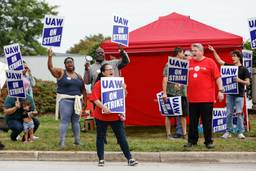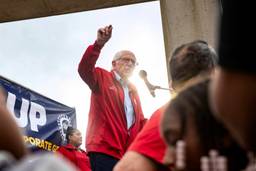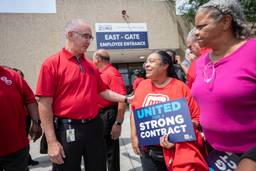Scott Walker and Bruce Rauner’s Assaults On Organized Labor Are Also an Opportunity
Elizabeth Tandy Shermer

The news out of the Midwest gets grimmer by day. Governor Scott Walker dramatically signed a right-to-work law on Monday. He called it “freedom-to-work legislation,” a blatantly transparent sales pitch for a bill that only Wisconsin’s hopelessly jerrymandered legislature could pass. And in neighboring Illinois, newly-elected Republican Governor Bruce Rauner has all but declared war on unionists. He has endorsed local right-to-work law ordinances and bans on public-employee union contributions to political campaigns and issued executive orders against the “fair-share fees” that cover the costs of unions protecting all employees’ wages, benefits, and workplace rights (regardless of whether or not they have joined the local).
But all of these attacks could do as much to enliven organized labor in this state as crush it.
That, after all, is what Arnold Schwarzenegger learned in 2005, when the then-governor engineered special off-year ballot initiatives billed as California’s “Year of Reform.” They were really an effort to tear apart the glimmers of a more progressive Golden State.
Proposition 74 took aim at teacher tenure, 75 tried to cut union political contributions, 76 sought to slash state spending — largely at the expense of California’s already starved schools, and 77 nakedly facilitated jerrymandering. There was, just for good measure and a better turnout among the conservative base, a referendum on notifying parents if a minor sought an abortion.
And the “Governator” openly admitted these proposed statutes and constitutional amendments were about his power. Without Propositions 74, 75, 76 and 77, he claimed that he could not govern as he saw fit. And despite the millions spent in this election (then California’s most expensive), he could not convince voters to turn on teachers, unionists, and school children. 2005 ended up being Schwarzenegger’s Waterloo, which cost him $7 million of his own money, his earlier widespread popularity and ultimately his plans for a political career in Washington.
Teachers, nurses, and firefighters were the ones who defeated the once-and-future Terminator. To be sure, shock, rage, and fear had greeted Schwarzenegger’s proposals. But unionists spent a year organizing amongst themselves and reaching out beyond their membership roles to explain how the governor’s reform agenda would deform California.
By April 2005, the governor had to drop the initiative to change public pensions. Opinion polls revealed Californians horrified that police and firefighters’ death and disability benefits would be cut. By the summer, Democrats reported that they could “see blood in the water.” Parents appeared in advertisements to declare he was “breaking his word on education.” It was clear to them that these referenda would do nothing “to reduce class sizes and keep quality teachers.”
Schwarzenegger’s approval ratings continued to plummet as November drew closer. Already, California Nurses Association’s director Rose Ann Demoro could be confident that “the mainstream has turned on him.” Schwarzenegger had clearly been bested on election night, when Californians rejected each proposal by a wide margin.
But unionists were well aware why they had won. “On the ground and especially in the local labor councils, we were united to beat Schwarzenegger,” an AFSCME leader emphasized. A teacher openly admitted, “The best thing Arnold ever did was bring us all together.”
Let’s hope Midwesterners say the same thing about Walker and Rauner a year from now. Their plans are out of the same conservative playbook as Schwarzenegger’s.
Wisconsinites and Illinoisians have a real opportunity to stop these Republicans’ local and national ambitions and hopefully repeal what they’ve already foisted on residents. And, to their credit, union leaders are already intensifying internal organizing efforts against what Illinois AFSCME Council 31 director Roberta Lynch called a “scheme to strip the rights of state workers.” And the labor movement has already built coalitions to challenge right-to-work rules. Over 400 businesses joined the Wisconsin labor movement in opposing the bill that Walker just signed.
There is no reason that Midwesterners could not build even larger, more powerful alliances, like the ones that kept California among the more progressive states and halted Schwarzenegger’s national ambitions. There was an outpouring of support from around the country when public employees occupied the Wisconsin Capitol in 2011. And Illinois residents have already expressed discomfort, if not outrage, over Rauner’s ideas to slash school spending, upend the pension program, and make taxation even more regressive. These proposals, like Wisconsin’s right-to-work law, are as much a threat as an opportunity to build the kind of alliances to safeguard the economic rights embedded in labor law and improve the standard of living for everyone in the Midwest.

I hope you found this article important. Before you leave, I want to ask you to consider supporting our work with a donation. In These Times needs readers like you to help sustain our mission. We don’t depend on—or want—corporate advertising or deep-pocketed billionaires to fund our journalism. We’re supported by you, the reader, so we can focus on covering the issues that matter most to the progressive movement without fear or compromise.
Our work isn’t hidden behind a paywall because of people like you who support our journalism. We want to keep it that way. If you value the work we do and the movements we cover, please consider donating to In These Times.



